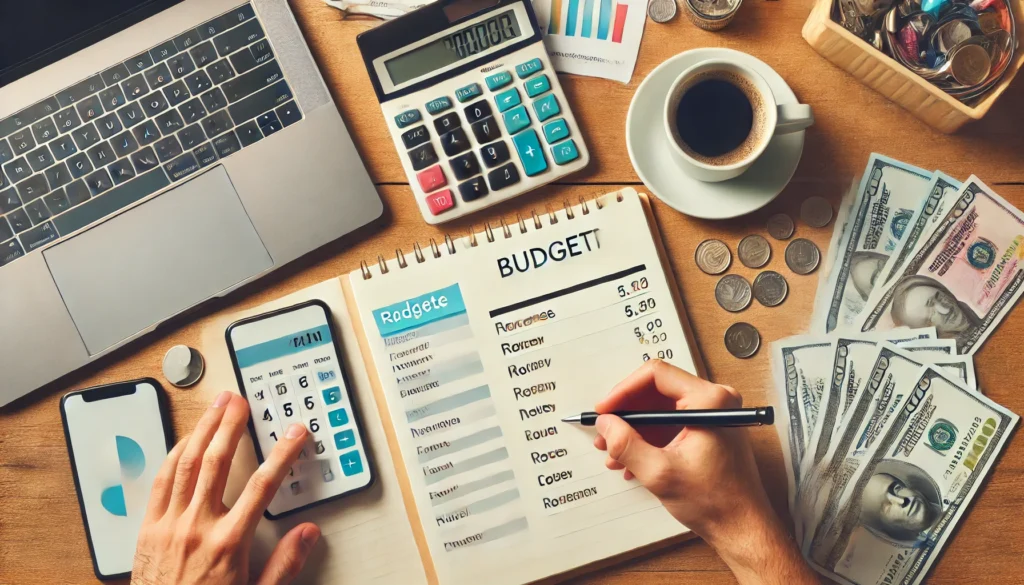Why Learning How to Stick to a Budget Matters More Than Ever
In today’s complex economic landscape, where prices fluctuate unpredictably and consumer temptations are more accessible than ever, mastering the art of budgeting is no longer optional—it’s essential. Learning how to stick to a budget is the cornerstone of financial well-being and long-term wealth accumulation. Whether you’re dealing with student loans, managing household expenses, or preparing for major life changes, budgeting gives you control, clarity, and peace of mind.
You may also like: 10 Genius Frugal Living Hacks: Effective Ways to Save Money on Household Bills
The question many ask is, “How do you stick to a budget without feeling deprived or overwhelmed?” It’s a fair concern, especially when most mainstream advice focuses on cutting out lattes or skipping vacations. True budgeting success, however, lies not in sacrificing joy, but in aligning your spending with your values and priorities. Frugal living isn’t about living smaller; it’s about living smarter.
This article explores ten actionable, expert-approved tips for sticking to a budget, each infused with practical frugal living hacks that actually save you money. These aren’t just abstract concepts—they’re grounded in real-world application, supported by financial psychology, and designed to help you build a sustainable system for your money.

Start with a Realistic Budget That Reflects Your Actual Spending
Many people fail at budgeting not because they lack discipline, but because they start with unrealistic expectations. A budget that looks perfect on paper but fails to reflect your actual spending habits will collapse the moment reality sets in. The key to sticking to a budget is honesty—both with yourself and your numbers.
Begin by tracking your expenses for at least one full month before setting up a formal budget. Use tools like expense tracking apps, bank statement reviews, or a simple spreadsheet to get an accurate picture of your cash flow. Include everything from fixed bills to random coffee runs. This exercise isn’t about judgment; it’s about awareness. You can’t improve what you don’t measure.
Once you have a clear picture, categorize your expenses into essentials, savings, and discretionary spending. From there, craft a budget that mirrors your real-life needs rather than an idealized version of yourself. Budgeting for a lifestyle you don’t actually lead will always backfire. The closer your budget aligns with your current habits, the more likely you are to stick with it, even as you make gradual improvements.
Automate Everything You Can to Reduce the Temptation to Overspend
One of the simplest yet most effective ways to stick to a budget is to remove human error from the equation. By automating key aspects of your financial life—from bill payments to savings contributions—you not only ensure consistency, but you also make it harder to deviate from your plan. Automation transforms your financial goals into defaults rather than decisions.
Set up automatic transfers from your checking account to your savings account as soon as you receive your paycheck. This “pay yourself first” strategy ensures that saving becomes non-negotiable. Automate recurring bills like rent, utilities, insurance, and subscriptions to avoid late fees and interest charges. When payments are taken care of behind the scenes, you’re less likely to accidentally spend money that was earmarked for essentials.
Additionally, consider automating contributions to investment accounts, whether it’s a Roth IRA, 401(k), or even a high-yield savings account. This approach allows you to build long-term wealth consistently while keeping you aligned with your budget. The more you remove manual intervention from your finances, the easier it becomes to stay on track with minimal effort.
Create a Zero-Based Budget to Assign Every Dollar a Purpose
A zero-based budget is one of the most powerful tools for financial clarity and discipline. Unlike traditional budgets that leave a surplus or “wiggle room,” a zero-based budget ensures that every dollar you earn is allocated to a specific purpose. Whether it’s rent, groceries, savings, debt repayment, or entertainment, nothing is left unassigned.
This method forces intentionality. You’re not just spending money until it runs out; you’re giving each dollar a job before the month begins. By doing this, you gain a deeper sense of control and accountability. You’re also less likely to fall into the trap of impulse purchases or mindless spending.
To make this approach work, start by listing your total income for the month. Then, break down your expenses into detailed categories, including both fixed and variable costs. Don’t forget to account for seasonal expenses or irregular bills. If you find that your expenses exceed your income, you’ll need to adjust by reducing discretionary spending or finding ways to boost your income. The beauty of a zero-based budget is that it provides instant feedback and a framework for smarter financial decisions.
Use Sinking Funds to Avoid Budget-Busting Surprises
Unexpected expenses are one of the main reasons people blow their budgets. But in reality, many of these “surprises” aren’t surprises at all—they’re simply irregular expenses that happen predictably, just not monthly. Car maintenance, annual insurance premiums, holiday gifts, and back-to-school shopping are all foreseeable events.
That’s where sinking funds come in. A sinking fund is a savings strategy where you set aside small amounts of money each month for a future expense. Instead of scrambling to come up with $600 for car repairs, you slowly accumulate that amount over time, reducing stress and protecting your monthly budget.
To set up sinking funds, start by listing out irregular expenses you can anticipate over the next year. Estimate the cost and divide that amount by the number of months until the bill is due. Set up a separate savings account or sub-account for each fund, and automate contributions if possible. By spreading out the cost of large, non-monthly expenses, sinking funds help ensure your core budget remains intact.
Reevaluate Subscriptions and Recurring Charges Regularly
In the age of digital convenience, it’s easier than ever to sign up for recurring subscriptions—and far harder to remember or cancel them. Streaming services, meal kits, subscription boxes, fitness apps, and cloud storage all add up quickly, often flying under the radar of your conscious spending.
One of the most effective tips for sticking to a budget is to audit your subscriptions regularly. Set a reminder to review all automatic charges every three to six months. Ask yourself if you still use the service, whether it’s worth the cost, and if there are lower-cost or free alternatives available. Often, people continue paying for subscriptions they forgot about or barely use out of habit or inertia.
Cutting out unnecessary recurring charges can free up significant money in your budget without impacting your lifestyle in any meaningful way. Redirect those funds toward savings, debt repayment, or other high-priority goals. Remember, frugal living isn’t about cutting out what you love—it’s about eliminating what no longer serves you.
Shop with a List and a Purpose to Avoid Impulse Buying
Impulse purchases are a budget’s worst enemy. Whether it’s a spontaneous takeout order, a sale item you didn’t plan to buy, or a late-night online shopping spree, these small decisions add up quickly and can derail even the most carefully planned budget.
The solution lies in intentionality. One of the simplest yet most transformative frugal living hacks is to always shop with a list. Whether you’re heading to the grocery store or shopping online, a list keeps you focused and aligned with your needs rather than your impulses. It serves as a psychological barrier against marketing tricks and emotional decision-making.
Before you shop, take stock of what you already have and identify exactly what you need. Stick to your list, and if you find something that tempts you, give yourself a 24-hour cooling-off period before making the purchase. More often than not, the urge will pass, and your budget will thank you.
Embrace the 24-Hour Rule for Discretionary Spending
Emotional spending often feels justified in the moment but leads to regret later. One of the most powerful strategies to curb this behavior is the 24-hour rule. This rule states that you should wait at least 24 hours before making any non-essential purchase. It gives you time to evaluate whether the item aligns with your financial goals or is simply a fleeting desire.
This cooling-off period helps shift your mindset from reactive to reflective. You create space to consider whether you genuinely need the item or if the purchase would disrupt your budget. Implementing the 24-hour rule also trains your brain to associate spending with mindfulness, helping you build healthier money habits over time.
Use a note-taking app or browser bookmark folder to save items you’re considering. If you still want them after 24 hours—and they fit within your budget—go ahead. But you’ll often find that the urge diminishes, especially when you view the item in the broader context of your financial goals. This simple practice can save you hundreds or even thousands annually.
Limit Credit Card Use and Stick to Cash or Debit for Daily Expenses
Credit cards can offer convenience and rewards, but they also pose a significant risk to budget discipline when not managed carefully. Swiping a card doesn’t trigger the same psychological impact as handing over cash, which can lead to unconscious overspending. If you’re struggling to stick to a budget, consider limiting credit card use for daily purchases.
Switching to cash or debit makes your spending feel more tangible and immediate. When the money is gone, it’s gone—which naturally curbs impulsive behavior. This tactile feedback helps you stay within your budget and prioritize essential purchases over spontaneous splurges.
Consider adopting a cash envelope system for variable expenses like groceries, dining out, and entertainment. Allocate a specific amount to each category and use only what’s in the envelope. This method creates a built-in accountability mechanism and makes it easier to track your spending in real time.
While credit cards can still play a role in your financial strategy, reserving them for planned, budgeted expenses—or emergencies—helps you avoid debt and maintain better control over your money.
Conduct Weekly Money Check-Ins to Stay Accountable
Sticking to a budget is not a set-it-and-forget-it task. Just like physical health requires regular check-ins and course corrections, so does financial health. Weekly money check-ins are a powerful way to stay accountable, spot problems early, and celebrate progress.
Set aside 15 to 30 minutes each week to review your income, expenses, and budget categories. Identify areas where you went over or under, and adjust accordingly for the following week. These sessions don’t have to be formal or overwhelming—even a casual review with a cup of coffee can be effective.
Use this time to log receipts, reconcile bank statements, and assess whether your financial habits are supporting your larger goals. If you share finances with a partner, make these check-ins collaborative. They’re an opportunity to strengthen communication and work together toward shared objectives.
The more frequently you engage with your money, the more connected and in control you’ll feel. Weekly reviews keep your financial life from drifting off course and empower you to make small adjustments before they become big problems.
Celebrate Milestones to Stay Motivated on Your Budgeting Journey
Budgeting can feel restrictive if you only focus on what you’re cutting out. That’s why celebrating milestones is so important. Recognizing progress—whether it’s paying off a credit card, sticking to your budget for three straight months, or reaching a savings goal—provides the emotional fuel to keep going.
Milestone celebrations don’t have to be expensive. A homemade dinner, a night off from cooking, or a day trip to a local park can feel just as rewarding as a costly splurge. The key is to honor your achievements in a way that reinforces your financial values.
When you make your goals visible—by tracking them on a chart, app, or journal—you create a positive feedback loop. Each small win builds confidence and motivation, making it easier to stick to your budget even when challenges arise. Budgeting is a long-term habit, not a short-term fix, and celebrating milestones ensures you stay emotionally invested in the journey.

Frequently Asked Questions (FAQ) on Sticking to a Budget
1. Why do most people struggle with sticking to a budget?
Many people struggle with sticking to a budget because they approach it with an overly restrictive mindset. Instead of seeing budgeting as a tool for financial freedom, they often view it as a form of deprivation. Psychological factors such as impulse spending, lifestyle inflation, and emotional shopping can make it difficult to adhere to a financial plan. A more sustainable approach is to frame budgeting as a way to prioritize personal values and long-term financial stability. By making room for small indulgences within a structured plan, individuals can maintain motivation while still achieving their savings goals.
2. What are some advanced tips for sticking to a budget without feeling restricted?
To stick to a budget without feeling restricted, consider the 80/20 rule: allocate 80% of your budget toward necessary expenses and savings, leaving 20% for flexible spending. This method ensures financial discipline while allowing for spontaneity. Additionally, leveraging automation tools, such as scheduled transfers to savings accounts, helps reinforce consistent financial habits. Implementing gamification, like setting financial challenges or using apps that reward savings, can also make budgeting more engaging. Another overlooked strategy is practicing mindful spending—before making any purchase, assess whether it aligns with your long-term financial goals.
3. How do psychological triggers impact budgeting habits?
Psychological triggers play a crucial role in budgeting success or failure. Many people engage in emotional spending to cope with stress, boredom, or societal pressure. Retailers also use strategic marketing techniques, such as limited-time offers, to create a sense of urgency that leads to impulse purchases. Understanding these triggers allows individuals to implement protective strategies, such as creating a 24-hour waiting period before making non-essential purchases. Journaling expenses and reflecting on the emotions tied to each transaction can help uncover spending patterns and prevent unnecessary financial leaks.
4. What are some innovative ways to stay accountable to your budget?
Accountability is key to maintaining a budget, and technology offers innovative solutions. Apps like YNAB (You Need a Budget) or PocketGuard provide real-time tracking and visual representations of spending patterns. Partnering with a “budgeting buddy” or joining online financial accountability groups can also enhance discipline. Another effective strategy is implementing a reward system—each time a budgeting goal is met, allocate a small portion for guilt-free spending. Publicly committing to financial goals on social media or within close circles can also provide external motivation to stay on track.
5. How does the envelope system compare to digital budgeting tools?
The envelope system involves allocating cash to different spending categories, making it a tangible and effective way to manage expenses. It limits overspending by providing a clear, physical representation of available funds. However, digital tools offer enhanced convenience, automation, and data analysis, allowing users to track trends over time. A hybrid approach—using envelopes for discretionary spending and digital tracking for fixed expenses—can combine the best of both methods. The key is choosing a system that aligns with personal financial habits and lifestyle preferences.
6. What role does lifestyle design play in sticking to a budget?
Lifestyle design involves intentionally structuring daily habits to align with financial goals. This could mean choosing a cost-effective commute, cooking at home instead of dining out, or embracing minimalist living. Many successful budgeters tailor their lifestyles to reduce expenses without compromising quality of life. For instance, relocating to a lower-cost area or negotiating bills can significantly free up funds for savings. By integrating budgeting principles into overall lifestyle choices, individuals can naturally align spending with long-term financial well-being.
7. How can someone adapt their budget when unexpected expenses arise?
Unexpected expenses are inevitable, which is why an emergency fund is crucial for financial resilience. Ideally, budgeting should include a “buffer category” to absorb minor surprises without derailing the entire plan. When a major unexpected cost arises, temporarily reallocating funds from non-essential categories can help manage the impact. Additionally, reviewing and adjusting financial priorities—such as pausing discretionary spending or negotiating payment plans—can ensure stability during financially turbulent periods. Regularly reassessing financial plans helps maintain flexibility while still working toward long-term goals.
8. What are some common myths about budgeting that prevent people from starting?
One common myth is that budgeting is only for people with financial struggles, when in reality, even high-income earners benefit from structured financial planning. Another misconception is that budgeting is time-consuming—modern apps and automation can make it effortless. Some believe that budgets are too restrictive, but effective plans actually provide financial freedom by eliminating wasteful spending. A prevalent myth is that budgeting means cutting out all luxuries; however, successful budgets allow for planned indulgences while prioritizing savings. Overcoming these misconceptions can encourage more people to embrace financial discipline.
9. How can small, daily habits contribute to long-term budgeting success?
Small daily habits, such as meal planning, using cashback apps, and negotiating recurring expenses, can significantly impact long-term financial health. Setting up automatic savings transfers ensures consistent progress toward financial goals without requiring conscious effort. Adopting a “no-spend” day each week can reinforce mindful spending habits. Tracking daily expenses, even briefly, builds awareness of spending patterns and helps prevent budget leaks. These incremental adjustments, when compounded over time, contribute to substantial financial stability and growth.
10. What are some emerging trends in personal finance that can enhance budgeting success?
Technology is revolutionizing personal finance, with AI-driven budgeting apps providing personalized insights based on spending behaviors. The rise of community-based financial accountability groups fosters shared learning and encouragement. Sustainable budgeting, which prioritizes long-term investments over short-term savings, is gaining popularity. Cryptocurrencies and digital banking innovations are also reshaping how individuals manage their finances. Staying informed about these emerging trends allows budgeters to leverage new tools and strategies to optimize their financial plans.

Conclusion: Budgeting Is a Mindset, Not a Math Problem
The real secret to how you stick to a budget lies not in spreadsheets or calculators, but in your mindset. Budgeting isn’t a one-time activity; it’s a lifestyle choice that reflects your values, priorities, and long-term goals. By applying these tips for sticking to a budget consistently and intentionally, you shift from reactive money management to proactive financial leadership.
Frugal living isn’t about deprivation. It’s about making smarter choices that stretch your resources and bring your life into greater alignment with what truly matters. Whether you’re just starting out or refining a well-established budget, the journey toward financial freedom is one of the most empowering paths you can take.
Use these proven strategies as your compass, and you’ll not only stick to your budget—you’ll thrive within it.
budgeting tips that work, frugal lifestyle strategies, smart money management, how to control spending habits, financial discipline techniques, saving money without stress, mindful spending strategies, building financial resilience, practical money-saving advice, cash envelope budgeting, simple financial planning methods, sustainable budgeting tips, conscious consumer habits, effective budgeting routines, realistic money goals, everyday frugality ideas, digital budgeting tools, managing finances wisely, tracking daily expenses effectively, improving financial self-control
Further Reading:
10 ways to save money: Smart savings tips
10 Tips for Setting a Budget you can Stick To
15 Tips For Setting Realistic Financial Goals And Sticking To Them
Legal Disclaimer
The information provided in this article is for general informational purposes only and is not intended to constitute financial, investment, legal, tax, or other professional advice. The content should not be relied upon for making any financial or investment decisions. Readers are encouraged to consult with licensed professionals, such as financial advisors, attorneys, or tax experts, to obtain personalized advice tailored to their individual circumstances. The author and publisher disclaim any liability for any actions taken or not taken based on the information provided in this article.





